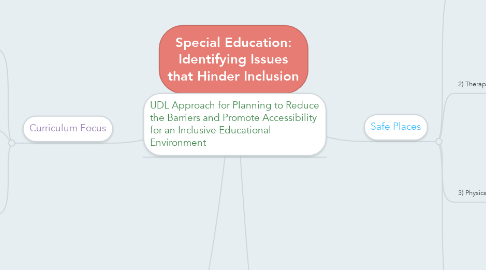
1. UDL Approach for Planning to Reduce the Barriers and Promote Accessibility for an Inclusive Educational Environment
2. Curriculum Focus
2.1. Project Based Learning
2.1.1. Students can focus on areas of passion
2.1.2. Caters to different learning styles
2.1.3. Promotes differential instruction
2.2. Functional Life Skills Built Into Courses and Daily Routines
2.2.1. Basic societal skills
2.2.1.1. Cooking
2.2.1.2. Personal Hygiene
2.2.1.3. Communication Skills
2.2.1.4. Sexual/Drug Education
2.3. New BC Curriculum
2.3.1. Open ended learning
2.3.2. Focus on big ideas VS trying to cover specific prescribed learning outcomes
2.3.3. Project based learning
2.3.3.1. A focus on content and developmental skills that are relevant for academic achievement and societal success VS memory and testing
3. Early Intervention
3.1. Multi-Agency Cooperation
3.1.1. Hired professionals for early screening assessment
3.1.2. Allows for a stronger support system that starts in the early stages and progresses as the student develops in life
3.1.3. Creates platforms for communication among experienced individuals and collaboration on important issues and practices
3.1.4. Allows for flexibility and shared time commitments
3.2. Response to Intervention (RTI)
3.2.1. Allows for a tiered intervention process that assists students with special needs and is an inclusive approach
3.2.2. FBA approach
3.2.2.1. Replacing behaviours/Teaching strategies
3.2.2.1.1. Stronger assessment of students
3.2.3. Student centered: once again focusing on functional needs VS Labeling
3.3. Reduction of Labelling
3.3.1. Focus on functional needs VS category labelling
3.3.2. Plan to move away from category funding and more towards block funding
3.3.3. Reduce paperwork for educators freeing up time for training or further education, plus a more clear goal of dealing with functional needs and strategies to do so
4. Safe Places
4.1. 1) Sensory Areas
4.1.1. Educational Sensory Tools
4.1.2. Sensory Objects
4.1.3. Aesthetically Appealing/Lighting
4.1.4. Quiet Tents/Boxes
4.1.5. Wiggle Seats
4.2. 2) Therapeutic Areas
4.2.1. Animal Therapy
4.2.2. Gardening/Farming Programs
4.2.3. Yoga/Meditation
4.2.4. Music Therapy
4.2.5. Water Therapy
4.3. 3) Physical Movement Areas
4.3.1. Running Spaces
4.3.2. Treadmill/Stationary Bikes
4.3.3. Punching Bags
4.3.4. Trampoline/Ball Pit
4.3.5. Medicine Balls
4.4. 4) Quiet Work Area
4.4.1. Individual desks with partitions
4.4.2. Private Spaces
4.4.3. Limited/Soft Lighting
4.4.4. Librarian Workshops/Tutoring
5. Training/Education/Experience
5.1. Appropriate Staffing/Educators
5.1.1. Trained teachers
5.1.2. Experienced support staff
5.1.3. Supportive/experienced administration
5.1.4. Specialized educators
5.1.5. Librarian/Resource coordinators
5.1.6. Research and assessment leaders
5.1.7. Specialists from other areas when and where needed (ie. dog therapist)
5.2. Teacher Development
5.2.1. Build in courses within teacher education program
5.2.1.1. Teach methods and strategies for inclusion
5.3. Mentoring Programs
5.3.1. Allow for expertise to be passed school wide
5.3.1.1. Allow school wide staff to productively work towards healthy inclusion of students with special needs/Gain experience needed to work with diverse learners
5.4. Teacher to Teacher/ Teacher to EA/ Teacher to Support Staff
5.4.1. Designate times within the school hours to collaborate around students needs and interventions
5.4.1.1. Educators will have necessary times to gain the experience needed to plan, implement, and establish strategies that work school wide versus class to class
5.5. Hire Experienced Educators
5.5.1. Plan times within school hours to collaborate with itinerant professionals, and have these professionals in the areas that support is needed
5.5.1.1. Allow for the appropriate staff to support students and teachers where needed, allowing for the right experience needed for inclusion

